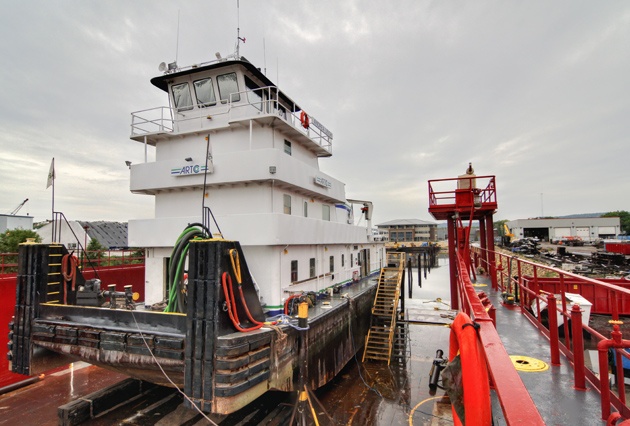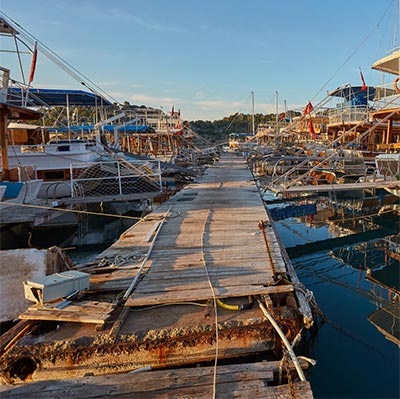Top Indicators You Need Professional Dock Repairs This Season
Top Indicators You Need Professional Dock Repairs This Season
Blog Article
Reliable Dock Fixing Techniques: Ensuring Structural Integrity
Making certain the structural honesty of docks through reliable repair service techniques is extremely important for the durability and safety of marine centers. Consequently, picking the best fixing materials, such as corrosion-resistant alloys and composite materials, is essential for longevity.
Evaluating Dock Damages
Assessing dock damages is a vital very first step in ensuring the structural stability and safety of any type of docking center. This initial analysis includes a comprehensive assessment to recognize both visible and covert problems. Key facets to examine include the dock's structure, pilings, outdoor decking, and hardware. Each element needs to be looked at for signs of wear, rot, rust, or other kinds of degradation that might endanger the structural stability.
Architectural designers or certified assessors typically perform these evaluations utilizing specialized techniques and tools. Underwater evaluations might employ sonar equipment or remotely ran automobiles (ROVs) to discover submerged damage. Above water, aesthetic examinations are enhanced by utilizing dampness meters and various other analysis devices to reveal underlying problems not quickly noticeable to the naked eye.

Finding Repair Service Products
Choosing the proper repair service materials is a critical step in the dock restoration process, one that straight influences the longevity and efficiency of the repaired structure. Material choice have to be driven by variables such as environmental conditions, load-bearing requirements, and compatibility with existing dock elements.
In addition to wood, composite materials are progressively preferred due to their toughness and low maintenance needs. Composites, generally made from a blend of plastic and wood fibers, provide superb resistance to rot, insects, and UV damages. For steel docks, choosing corrosion-resistant alloys such as galvanized steel or marine-grade aluminum is important to avoid rust and make sure structural stability in saline water conditions.
Epoxy materials and marine-grade sealants are crucial for repairing fractures and securing joints, providing a water resistant obstacle and enhancing the dock's general toughness. By meticulously selecting high-grade materials, dock repair services can attain long-lasting results, consequently guarding against future deterioration and ensuring safe, trustworthy usage.
Structural Reinforcement Strategies
Effective structural support techniques are vital in making sure the security and longevity of dock repair work. One basic approach includes using steel or composite reinforcement bars (rebar) within concrete frameworks. Rebar supplies added tensile strength, avoiding splits and dispersing lots more uniformly. This technique is particularly effective for docks exposed to heavy tons or extreme ecological problems.
Another important technique is the application of fiber-reinforced polymers (FRP) These products use high strength-to-weight ratios and outstanding resistance to corrosion, making them excellent for enhancing concrete or wooden anchors. FRP can be used in sheets or strips and bound with epoxy resins to boost architectural integrity.
Supporting and securing systems also play an essential role in architectural reinforcement. Cross-bracing, using steel or wooden light beams, can combat lateral pressures, minimizing swaying and activity. Anchoring systems, such as helical piers or driven piles, supply a stable structure by transferring loads to much deeper, more secure soil layers.
Last but not least, the combination of load-distribution plates can assist distribute weight extra uniformly throughout the dock's surface area, mitigating local tension factors. These that site methods collectively make certain that docks continue to be durable and safe, capable of holding up against the rigors of their functional atmosphere.
Advanced Fixing Techniques

Another advanced technique includes underwater welding, which enables repair services to be conducted without the need to dewater the area. This technique is especially helpful for attending to structural problems in submerged dock components, guaranteeing minimal disruption to operations. Boosted welding strategies, paired with robot systems, supply precision and reliability, consequently extending the lifespan of the dock.
Additionally, cathodic defense systems are carried out to avoid deterioration in metal dock frameworks. By utilizing sacrificial anodes or satisfied current systems, these techniques effectively reduce the electrochemical processes that result in material deterioration.
Last but not least, progressed tracking technologies, such as architectural wellness tracking (SHM) systems, offer real-time data on the problem of dock structures. These systems make it possible for positive maintenance and prompt interventions, inevitably ensuring the lasting architectural stability of the dock.
Maintenance and Avoidance
Maintenance and avoidance are fundamental principles that underpin the durability and safety and security of dock frameworks. Regular assessments are critical, enabling early discovery of deterioration, possible weaknesses, and ecological impacts. An aggressive approach, including routine checks for deterioration, rot, and structural changes, reduces pricey repair work and lengthens the dock's operational life.
Precautionary actions ought to consist of applying protective coatings to metal parts to protect versus corrosion and using cured wood to withstand degeneration. Additionally, making sure proper drain and air flow can prevent water build-up, which is an usual reason for structural destruction. Incorporating high quality products and adhering to producer standards throughout building and construction and repair work phases additionally play crucial More Help roles in improving durability.

Educating employees in dock maintenance best techniques guarantees consistent application of preventive measures. Leveraging technical breakthroughs, such as drones for examinations and sensors for real-time surveillance, can additionally improve maintenance initiatives. By focusing on maintenance and avoidance, dock proprietors can make sure structural honesty, functional security, and cost-effective monitoring over the dock's life-span.
Final Thought
In conclusion, preserving the architectural honesty of marine facilities requires thorough dock repair methods. Advanced repair service strategies, Going Here coupled with routine maintenance methods, make certain the dock remains functional and secure under varied ecological conditions.
Making certain the architectural honesty of anchors with reliable repair techniques is vital for the durability and safety and security of aquatic facilities.Selecting the ideal repair products is a pivotal step in the dock restoration procedure, one that directly influences the durability and efficiency of the fixed framework.Efficient architectural support strategies are critical in ensuring the stability and longevity of dock repairs. By focusing on upkeep and avoidance, dock owners can guarantee structural integrity, functional safety and security, and cost-efficient monitoring over the dock's life-span.
In final thought, preserving the structural integrity of aquatic centers requires comprehensive dock repair strategies.
Report this page